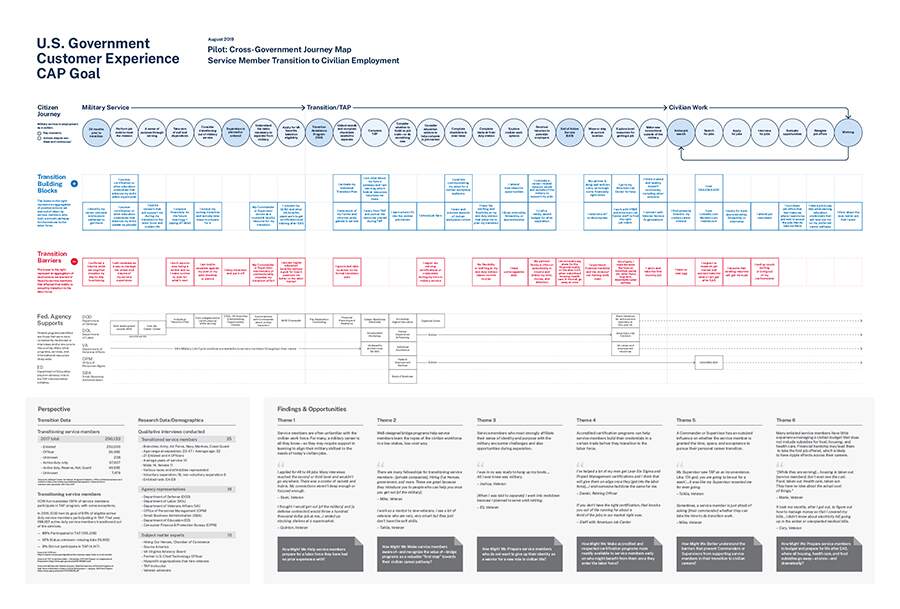Tags:
PMA CAP Goal
Meet Charlotte. She is a resident of Northern California who survived the devastating Camp Fire which burned nearly 154,000 acres. Her house where she lives with her aging mother, husband, and three children was destroyed and her family farm severely damaged.
To Charlotte, this is a tragic life event that is upending her existence. To the Federal Government, it triggers possible eligibility for programs spread across dozens of agencies, not to mention state and local government and charities. It might mean assistance from the U.S. Department of Agriculture for the farm, a loan from the Small Business Administration, grants from the Federal Emergency Management Agency, help from the Department of Housing and Urban Development for housing, and help from the Department of Health and Human Services for health challenges. Each has their own process, regulations, and paperwork.
Imagine if the U.S. government understood how each of its services were part of a broader customer journey. How might federal agencies change their approach or even work together? How might citizens think differently about those services and their overall experience with government?
A journey is one way to look at an experience and tell a story. Many in the private (and now public) sector use a process of “journey mapping” to provide multiple stakeholders with a common understanding of how a customer interacts with a service. You may have heard of tools like “user personas,” “customer maps,” “user journeys,” “behavioral maps,” “service blueprints,” and more. It is looking at the fire and subsequent services from the perspective of Charlotte.

Our team believes deeply in these processes to build shared knowledge of customer needs, using a physical artifact to ground conversations about improvements and priorities. These journeys can be mapped at all kinds of levels – from a specific interaction visiting a service center to change your name and apply for a new Social Security card, to an individual’s overall lifetime experience interacting with the Social Security Administration.
A holistic customer understanding
When working across government organizations, it is important to capture both the front stage experience (what customers see) and the backstage operations (what makes this experience possible). This may include:
- Qualitative Customer Data: From customer feedback surveys instrumented at each interaction or transaction to extensive, representative interviews across the country, the purpose of this layer is to hear directly from people served in their own words. This data provides an understanding of what customers want, expect, and need from a system, product, or experience. Qualitative interviews shed light on how people see the world—their beliefs, mindsets, and how they think about the problem—and can help providers better understand what else is influencing how customers experience their service.
- Process: During this step-by-step mapping, actions taken by customers, employees, or other entities involved in services being acquired or delivered can be evaluated. Especially when processes involve handoffs or multiple teams in service delivery, it is critical to ensure every step is captured accurately, checking assumptions we make about others’ roles. When completing specific service maps, employee processes and actions are as important to capture as front-facing customer steps.
- Rigorous Research and Behavioral Data: Sometimes what people say and what they do are entirely different things. This is where it is critical to have an understanding of behavioral science, or knowledge of how people access, process, and act on information. Environmental factors, such as how forms are structured or who is relaying information, can affect how an individual responds. Conducting literature reviews related to particular choke points in a system or finding rigorous evaluations of similar challenges can help add evidence-based insight.
- Operational Performance Data: Understanding how a process works at the nuts and bolts level is vital. Performance metrics such as application processing volumes, engagement channel type, key performance indicators, service level agreements, and cost per transaction provide important information about what is actually happening with customers and within the organization. For example, a provider may hypothesize what a customer group finds confusing about a federal benefit program. Yet when they review data on actual customer questions, they may find more individuals are actually seeking information to address a different issue.
Together, these layers can build a more accurate picture of what matters most to customers, what drives the outcome of an organization’s mission, and where there is potential for a return on investment.
The Federal Government currently has no entity responsible for maintaining the perspective of the user (like Charlotte) or building this holistic view of how people interact with and navigate public services. When adopting a customer perspective, gaps in service and opportunities for improvement immediately become clear:
- Farmers hiring a seasonal worker under an H-2A visa must navigate at least four federal agencies
- Service members seeking resources to support their transition to a new career often navigate programs and resources across at least seven federal agencies
- Small business owners must apply for an Employer Identification Number from the Internal Revenue Service, submit new hire paperwork to the Department of Homeland Security, meet health insurance requirements with the Department of Health and Human Services, and address workplace safety codes with the Department of Labor
While many of these programs do their best to collaborate, and often provide good service within their silo, we know customers are frustrated with the gaps between our agencies. People experience life events, not federal agencies. Customer needs should shape and determine the delivery of government service. However, since Congress funds agencies, not life events, it is our responsibility to design coordinated services that bridge that gap.
The Federal Government’s first cross-agency journey map
Government typically approaches improvement and implementation from a bureaucratic, organizational-centered view. Our hypothesis is that a human-centered perspective will yield better results. After extensive research we decided to pilot the process of building a rich understanding of a U.S. Federal Government by focusing on the transition of active-duty service members to the civilian workforce.
In 2017, over 290,000 service members made this transition and taxpayers spend billions of dollars on programs supporting veterans employment. Veteran employment statistics have continued to improve, but there is more to the story.
Many veterans have jobs, but the jobs are low-wage and do not offer opportunities for advancement. The government programs that offer veterans support in their employment journey are not centralized or personalized to veterans’ individualized life circumstances. To better understand veterans’ day-to-day experiences finding work, we interviewed people whose backgrounds were similar to the majority of those now leaving the military and entering the labor market. That led us to focus on transitioned service members with some level of higher education coursework but no college degree who enlisted and served 10 years or fewer in the military. These veterans face a labor market that rewards applicants with higher education degrees and industry-specific certifications. If we can understand the pain points of this subgroup of veterans and help smooth their pathway towards meaningful work, we can make improvements that may benefit all veterans.
Orienting ourselves to the general process (as described in layer two of the holistic customer understanding above) of an individual transitioning out of the military from the perspective of the Department of Defense, Department of Labor, and Department of Veterans Affairs helped us identify subject matter experts and appropriate offices to interview.
We were fortunate to work with an outstanding team, many of whom have done previous design work serving veterans, to build the critical first layer described above (qualitative customer data). One to two hour interviews with 25 veterans in this profile, along with interviews with 18 stakeholders across 6 agencies, 10 subject matter experts, and Veterans Service Organizations, produced hundreds of pages of transcripts full of stories, insights, and patterns about the employment experience and associated support. We are excited to share the result of this work – a map of the transition from military service employment to employment in the civilian labor market.
This journey map is a composite of the experiences of the people we spoke with, and shows the steps and support as they articulated them. This map has four sections:
- At the top are a selection of key steps for service, transition, and employment. Each step acts as a column; anything below it roughly corresponds to the mindsets and support offered at that moment.
- Below the steps are building blocks and barriers to successful transition. These are actions or mindsets that were conducive or detrimental to successful transition to employment. Although everyone has a different story and therefore a different combination of these blocks, any actions taken by our federal programs to promote the building blocks or remove the barriers would improve the experience.
- Beneath those blocks are the federal agency supports as recalled by service members and veterans and mapped by agencies. At a high level, these supports were the major activities or programs offered during the end-to-end experience.
- Lastly, at the bottom we have findings and opportunities that summarize what we heard from the individuals. Our conversations confirmed that securing meaningful employment requires more than sending out resumes and landing interviews. The process of getting a good job is much more complex and can be influenced by things like financial literacy, commander support, and social networks.
As an employee of a federal agency, you may have drawn this customer journey map differently, or you may see omissions in a map like this. However, this map is drawn from the customer experience. It reflects what the actual people we talked to experienced, how they think and feel about what they experienced, and the resources they used or remembered along the way. It focuses not on what federal agencies do on paper, but what resonates for customers in reality. This is not a declarative document – it is a living artifact to help facilitate conversations. As a work in progress it can be refined and updated with additional insights from stakeholders, and new layers of data (qualitative, quantitative, operational, evaluative, and more) as we learn more.
Next steps
Now we are working with federal agencies and others at the White House to determine how we can use what we learned to improve a meaningful part of this journey. We have coalesced around three potential pilots that could help us learn more about the thematic areas where multiple agencies could improve the way they deliver services.
- Empower service members to better navigate the “sea of support” and overwhelming amount of programs, services, and benefits available to them at separation by providing more meaningful ways to connect and utilize or plan to utilize them while still actively serving
- Apply insights from the social and behavioral sciences to increase the use of savings and financial planning activities (like investing combat pay in a high yield savings account) to provide financial resiliency for service members and family as they transition to civilian employment
- Integrate the plethora of skills mapping, job-recommending, job-matching, and similar softwares to provide more streamlined options for those in service to begin planning and mapping career pathways
We want to share what we learn at each stage of the process and make resources available for other programs. If you are a government employee (at the federal, state, or local level) and would like to engage some of your colleagues in a conversation about how you collectively serve a customer group, you can use some of our guides and templates.
It does not need to be a formal, top-down effort. Consider simply enlisting a few passionate team members towards the goal of talking with customers and gaining a deeper understanding of how they experience government service. This work can get everyone outside of their day-to-day routine and provide new insights.
We look forward to providing additional updates in this space – you can follow our work at performance.gov/cx/.
Resource Links

